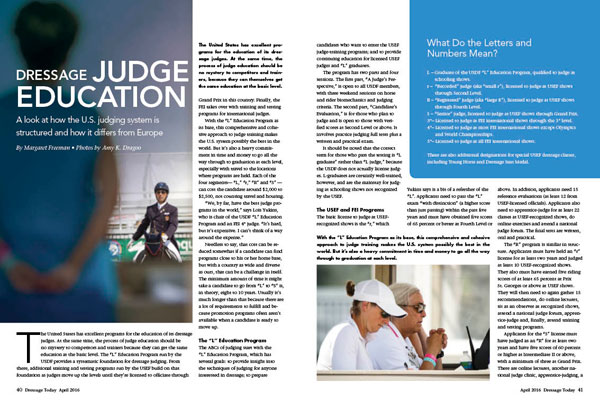It’s that time of year again, when lots of you are entering the show ring. If you show, you know all the prep work that goes into getting there: lessons, entry fees, learning your test, preparing your tack and show attire, making sure your trailer is stocked—the list goes on. All this work prepares you for your ride down centerline. But have you ever stopped to think about how the judges prepare for the task?

In this issue we learn what it takes to become a dressage judge in “Dressage Judge Education.” Written by Margaret Freeman, a USEF senior dressage judge and an FEI-level competitor, this article takes a closer look into how the U.S. judging system is structured and the amount of time and training it takes for our judges to earn that all-important position. Freeman takes us through the process, beginning with the “L” Education Program, which, she says, is a comprehensive and cohesive approach to judge training making the U.S. system possibly the best in the world. You can read the full article on p. 40.
Knowing the judges are ready for your ride down centerline means it’s time to make sure you are, too. In “9 Tips for Riding a Winning Test” (p. 34) we hear insights from three judges—FEI 5* judges Anne Gribbons and Lilo Fore and “I” judge Hilda Gurney—on how you can improve your next test. From riding better centerlines and transitions to tips on how to read the test directives, the judges give sage advice to help you break into the top of your class.
With so much work going into getting ready to show, it’s sometimes easy to forget the importance of keeping your horse healthy on the road. In “Better Safe Than Sorry,” we hear from various vets, including Kentucky State Veterinarian Robert C. Stout, DVM, about how to best protect the health of your horse. “Going to an equestrian event and commingling with other horses of unknown status is always a risk, and basic biosecurity practices are the best way to address that risk,” says Stout. From making sure your horse’s vaccinations are up to date (a mandatory USEF requirement) to bringing and using your own water hose, you can greatly reduce the risks of transferring various diseases. You can also check out the new Equine Disease Communication Center website (equinediseasecc.org), which alerts the horse industry to disease-outbreak information to help mitigate and prevent the spread of disease. Be sure you don’t miss this important story on p. 46.
This issue is full of great information to help you prepare for your show season, including coverage of the recent USDF Trainers Conference, where Johann Hinnemann shared advice on how to develop a supple and obedient horse (p. 24).
Until next time…












